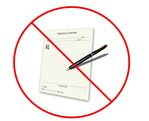Below are some guidelines/suggestions for altering workflows to fulfill the MU objectives.
1. Recording Demographics: Hopefully, this is not an alert that is popping up after the patient is checked in. Demographics are recorded in Experior (the practice management system our organization currently uses), and they are required fields. If you see an alert about demographics, double check that you are on the correct patient, and make sure you access him/her from the Daily Schedule tab.
2. Recording Vital Signs: We recommend that the clinical staff (nurses, medical assistants) enter the vital signs before the patient sees the provider. Most offices already have this workflow in place.
3. Maintaining the medication and allergy lists: This is one responsibility that is still up in the air for many offices. It should be made absolutely clear who will be reconciling the allergy and medication lists. Nurses or providers can do it, but making sure it gets done is essential. We recommend that whoever updates the medical history also reconciles the medications and allergies. Some providers feel more comfortable going over the list themselves, but he/she needs to communicate this to the staff.
4. Maintain an up-to-date problem list of current and active diagnoses: The keyword here is DIAGNOSES, which means this requirement is a provider responsibility. That also means that providers can’t simply “free text” the diagnoses in the note. They have to be added to the clinical desktop. Keep in mind, active problems can be added to the desktop and to the note from within the note, so there is no need to close the note to add them. If the office elects to do so, to save the provider time on new patients (i.e. either those who are new to the practice or new to the EHR system), clinical staff can preload the medical history, and then providers can update histories into active problems. Remember, however, that this only saves searching time. The provider still needs to click on the history item and update it.
5. Permissible prescriptions written by the provider are generated and transmitted electronically. Simply put, STOP USING YOUR PRESCRIPTION PAD. For the current med list to be accurate, scripts have to be entered into the system, either as history or to send to the pharmacy, so there is no good reason to write it on paper. The only time a script should be written out is when the system is down. Eventually, using the system to prescribe will speed up everyone’s workflow because the clinical staff can send per protocol refills by simply renewing the medication from the medication list.
6. Record smoking status: This status should be recorded on all patients 13 years and older. Who should be recording it? Examine the office workflow. It may be easier for the nurse taking vitals to record the information. But if he/she is getting backed up recording all of the other information, then the provider can and should do it —either from within the note or from the encounter summary. Remember, the keyword for searching for smoking status is “Smoke.” Select a status that has “MU” in front of it so that it meets CMS reporting criteria.
7. Provide clinical summaries for patients for each office visit within 3 business days. In last the last blog post, I provided some suggestions for dealing with this requirement. Until a patient portal is put into place, we highly recommend asking the patient at check out if he/she wants a copy of the summary. Postage costs would be too much to mail these out. Familiarize yourself with the output of the document so that you are clear on what the patient receives, and if finishing the note is impossible before the patient leaves, at least get through the plan: Diagnose and Order.
8. Implement one clinical decision support rule. Before the reporting period, the organization will determine what rule will be put in to place and tracked. We recommend getting familiar with the Health Management Profile (HMP tab) and using it to set up reminders for your patients’ health maintenance items.

 RSS Feed
RSS Feed